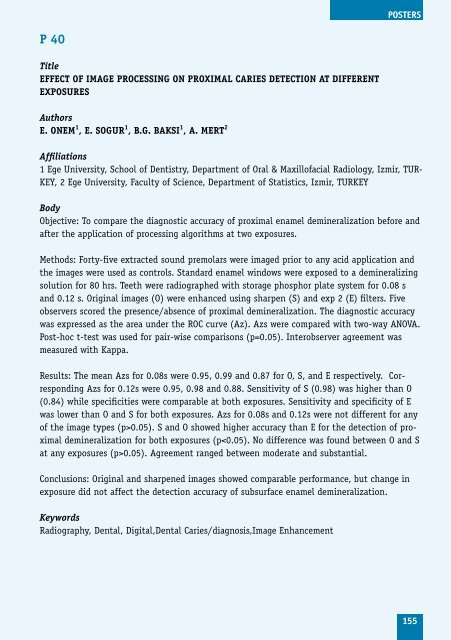Program including abstracts as pdf available here
Program including abstracts as pdf available here
Program including abstracts as pdf available here
Create successful ePaper yourself
Turn your PDF publications into a flip-book with our unique Google optimized e-Paper software.
P 40<br />
Title<br />
EFFECT OF IMAGE PROCESSING ON PROXIMAL CARIES DETECTION AT DIFFERENT<br />
EXPOSuRES<br />
Authors<br />
E. ONEM 1 , E. SOGuR 1 , b.G. bAKSI 1 , A. MERT 2<br />
Affiliations<br />
1 Ege University, School of Dentistry, Department of Oral & Maxillofacial Radiology, Izmir, TUR-<br />
KEY, 2 Ege University, Faculty of Science, Department of Statistics, Izmir, TURKEY<br />
Body<br />
Objective: To compare the diagnostic accuracy of proximal enamel demineralization before and<br />
after the application of processing algorithms at two exposures.<br />
Methods: Forty-five extracted sound premolars were imaged prior to any acid application and<br />
the images were used <strong>as</strong> controls. Standard enamel windows were exposed to a demineralizing<br />
solution for 80 hrs. Teeth were radiographed with storage phosphor plate system for 0.08 s<br />
and 0.12 s. Original images (O) were enhanced using sharpen (S) and exp 2 (E) filters. Five<br />
observers scored the presence/absence of proximal demineralization. The diagnostic accuracy<br />
w<strong>as</strong> expressed <strong>as</strong> the area under the ROC curve (Az). Azs were compared with two-way ANOVA.<br />
Post-hoc t-test w<strong>as</strong> used for pair-wise comparisons (p=0.05). Interobserver agreement w<strong>as</strong><br />
me<strong>as</strong>ured with Kappa.<br />
Results: The mean Azs for 0.08s were 0.95, 0.99 and 0.87 for O, S, and E respectively. Corresponding<br />
Azs for 0.12s were 0.95, 0.98 and 0.88. Sensitivity of S (0.98) w<strong>as</strong> higher than O<br />
(0.84) while specificities were comparable at both exposures. Sensitivity and specificity of E<br />
w<strong>as</strong> lower than O and S for both exposures. Azs for 0.08s and 0.12s were not different for any<br />
of the image types (p>0.05). S and O showed higher accuracy than E for the detection of proximal<br />
demineralization for both exposures (p0.05). Agreement ranged between moderate and substantial.<br />
Conclusions: Original and sharpened images showed comparable performance, but change in<br />
exposure did not affect the detection accuracy of subsurface enamel demineralization.<br />
Keywords<br />
Radiography, Dental, Digital,Dental Caries/diagnosis,Image Enhancement<br />
POSTerS<br />
155


